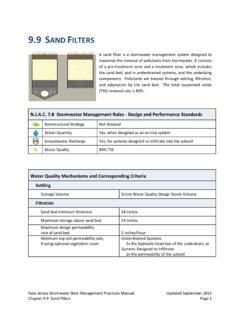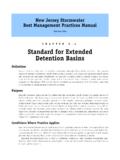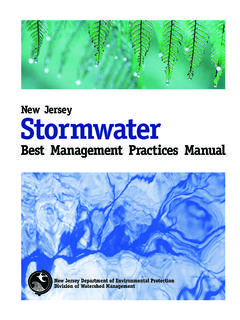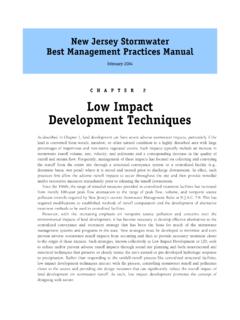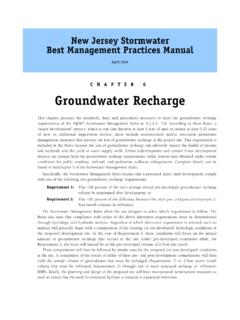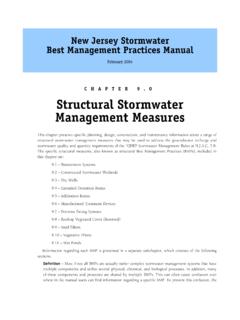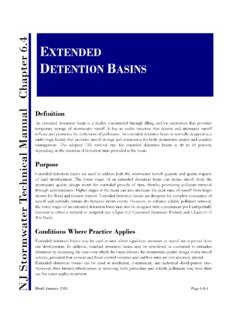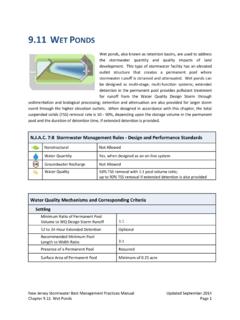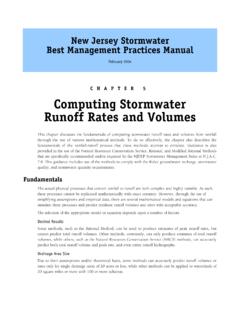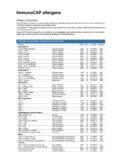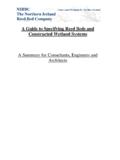Transcription of CHAPTER 7 Landscaping - njstormwater.org
1 New Jersey StormwaterBest Management Practices ManualFebruary 2004 CHAPTER 7 LandscapingLandscaping is critical to improving both the function and appearance of stormwater best managementpractices (BMPs). This CHAPTER provides Landscaping criteria and plant selection guidance for effectivestormwater BMPs. Part 1 describes the natural plant communities of New Jersey based on plant hardinesszones and physiographic regions. Plant selection for stormwater BMPs should match as closely as possiblethe natural plant communities of that region. Part 2 outlines general guidance that should be consideredwhen Landscaping any stormwater BMP. Part 3 presents more specific guidance on Landscaping criteria andplant selection for individual BMP designs described in CHAPTER 9. These include: constructed stormwater wetlands; infiltration basins and sand filter practices; bioretention systems; open channels; vegetative filters and forested buffers; wet ponds; and extended detention 4 considers plant acquisition and planting guidelines.
2 Part 5 deals with other plant considerations,such as vegetation maintenance, invasive species, plant availability, and SpeciesThis manual encourages the use of native plants in stormwater management facilities. Native plants aredefined as species that evolved naturally to live in this region. Practically speaking, this specifically refers tospecies that lived in New Jersey before Europeans explored and settled in America. Many introduced specieswere weeds brought in by accident; others were intentionally introduced and cultivated for use as medicinalherbs, spices, dyes, fiber plants, and ornamentals. 1 Parts of this CHAPTER were adopted directly from the 2000 Maryland Stormwater Design Manual (Schuelerand Claytor 2000). The CHAPTER also contains material added and adapted to the physiography, plant life,and growing conditions of New Jersey Stormwater Best Management Practices Manual CHAPTER 7: Landscaping February 2004 Page 7-2 Introduced species often escape cultivation and begin reproducing in the wild.
3 This is significantecologically because many introduced species out-compete or even replace indigenous species in the introduced or aggressive species are invasive, have few predators, and can take over naturallyoccurring species at an alarming rate. These include reed canary grass (Phalaris arundinacea), phragmites(Phragmites communis), kudzu (Pueraria spp.), purple loosetrife (Lythrum salicara), Norway maple (Acerplatanoides), autumn olive (Elaeagnus umbellata), Japanese honeysuckle (Lonicera japonica), Japanese rose(Rosa muliflora), garlic mustard (Alliaria officinalis), birdsfoot trefoil (Lotus corniculatus), lesser celandine(Ranunculus ficaria), and cattail (Typha latifolia). By planting non-aggressive, native species in stormwatermanagement facilities, we can protect New Jersey s natural heritage, encourage biodiversity, and provide alegacy for future : Although both phragmites and cattails can be invasive, they also provide water quality and somewildlife benefits.
4 These species should not necessarily be recommended and, if they do appear on site, it isquestionable whether a considerable amount of effort or money should be spent controlling or eradicatingthese species have distinct genetic advantages over non-native species for planting in New they have evolved to live here naturally, indigenous plants are best suited for our local climate. Thistranslates into greater survivorship and less replacement maintenance during the life of a stormwatermanagement facility. Both of these attributes provide cost savings for facility , people often plant exotic species for their ornamental value. While it is important to plantaesthetic stormwater management facilities for public acceptance and maintenance of property value, it isnot necessary to introduce foreign species for this purpose. Many native species can be used as following species are part of New Jersey s natural heritage and provide high aesthetic value throughoutthe year: rhododendron (Rhododendron maximum), pink azalea (Rhododendron nudiflorum), red maple(Acer rubrum), pin oak (Quercus palustris), sycamore (Platanus occidentalis), flowering and shrubdogwoods (Cornus spp.)
5 , mountain laurel (Kalmia latifolia), willow (Salix spp.), white pine (Pinus strobus),Atlantic white cedar (Chamaecyparis thyoides), American holly (Ilex americana), swamp rose (Rosapalustris), sunflowers (Helianthus spp.), lobelias (Lobelia spp), pickerel weed (Pontederia cordata), swamprose mallow (Hibiscus moscheutos), and yellow pond lily (Nuphar avena).When selecting ornamentals for stormwater management facilities, planting preference should be givento native ornamentals. Refer to the plant lists in Part 5 for a list of native species available for stormwatermanagement facility 1: Natural Plant Communities of New JerseyPlant Hardiness ZonesHardiness zones are based on historical annual minimum temperatures recorded in an area. A BMP slocation in relation to plant hardiness zones is important because plants differ in their ability to withstandvery cold winters. This does not imply that plants are not affected by summer temperatures; New Jerseysummers can be very hot, and heat tolerance should be considered in plant selection as is best to recommend plants known to thrive in specific hardiness zones.
6 The plant list included at theend of this CHAPTER identifies the hardiness zones for each species listed as a general planting guide. Itshould be noted, however, that certain site factors can create microclimates or environmental conditionsthat permit the growth of plants not listed as hardy for that zone. By investigating numerous references andusing personal experience, a designer should be able to confidently recommend plants that will survive Jersey Stormwater Best Management Practices Manual CHAPTER 7: Landscaping February 2004 Page 7-3 Table 7-1: USDA Hardiness Zones for New JerseyZoneUSDA Minimum Temperaturea-20 to -15 Temperate Zone 5b-15 to -10a-10 to -5 Temperate Zone 6b-5 to 0a0 to 5 Temperate Zone 7b5 to 10 Figure 7-1: USDA Plant Hardiness Zones Average Annual Minimum Temperature (New Jersey)This figure can be viewed in color in the PDF version of this CHAPTER available at Jersey Stormwater Best Management Practices Manual CHAPTER 7: Landscaping February 2004 Page 7-4 Physiographic ProvincesNew Jersey s five physiographic sections describe distinct geographic regions in the state with similarphysical and environmental conditions (Figure 7-2).
7 These physiographic provinces include, from west toeast, the Ridge and Valley, Highlands, Piedmont, Inner Coastal Plain, and Outer Coastal Plain. Eachphysiographic region is defined by unique geological strata, soil type, drainage patterns, moisture content,temperature, and degree of slope, which often dictate the predominant vegetation. Because the predominantvegetation has evolved to live in these specific conditions, a successful stormwater management facilityplanting design can be achieved through mimicking these natural five physiographic regions are described below with associated vegetation listed for general plantingguidance. 2 For more detailed information and plant listings, please refer to Plant Communities of NewJersey (Robichaud and Anderson 1994).Figure 7-2: The Five Physiographic Sections of New Jersey 2 These descriptions were adapted, in part, from Robichaud and Anderson 1994, and Robichaud and Buell : Robichaud and Anderson Jersey Stormwater Best Management Practices Manual CHAPTER 7: Landscaping February 2004 Page 7-5 Ridge and Valley SectionThe Ridge and Valley physiographic province in the northwestern corner of New Jersey covers 635 squaremiles or about 7 per cent of the total land in New Jersey.
8 It occupies a large part of Warren and Sussexcounties. Ridges and valleys occur in this section because parent rock formations underlying the ridges andthe valleys differ. Softer rocks such as limestone and shale erode faster than the more resistant sandstoneand conglomerates. The lowest valley levels occur wherever limestone underlies the surface; the areas ofshale, a slightly more resistant rock, are about 200 to 400 feet higher than the limestone, and ridges occurwherever the bedrock material is more resistant to erosion, such as sandstone or conglomerate in parent rock material not only account for the variation in relief, but also create contrasts inthe kind and amount of soil coverage. In general, the soil covering the Kittatinny and other ridges in thissection is poor in quality from the standpoint of vegetation. The soil layer is thin on the ridges, withbedrock exposed in many places.
9 Also, the ridge soil tends to be very acidic and of low fertility and, often,very contrast, the soils in the valleys, derived from limestone and shale that were covered by glacial till, arefor the most part deeper, more fertile, and well drained. Peat or large muck deposits (thick layers of organicmaterial) may occur where shallow glacial lakes once existed. These were later invaded by vegetation, thedead remains of which accumulated as peat or SectionThe Highlands physiographic province is located southeast of the Ridge and Valley section and covers about900 square miles or approximately 12 per cent of New Jersey s land area. As shown in Figure 7-2, thissection is broader at the north, where it is about 20 miles wide; at its southern end bordering the DelawareRiver Valley, it is only 10 miles wide. The Highlands region also has parallel ridges and valleys, but thesediffer from the Ridge and Valley section in the type of parent rock underlying the surface.
10 Also, the ridgesare more massive and generally much broader, while the valleys are narrower and have steeper rock outcroppings occur. Glacially formed lakes, such as Lake Hopatcong and Green Pond,contrast with adjacent ridges to make the Highlands a very scenic area of New geologic formations of the Highlands region are estimated to be approximately 1 billion years in the northern part of the basin in the Highlands average approximately 1,000 feet above meansea level, while the southern part of the Highlands show valley contours reaching a low of 350 feet. Ridgesof the Highlands have resisted erosion due to the very hard rock, sandstone, gneiss, granite, marble,quartzite, igneous, and metamorphic material of which they are made. Highland valleys consist of muchsofter materials of limestone or shale, making them less resistant to erosion.
